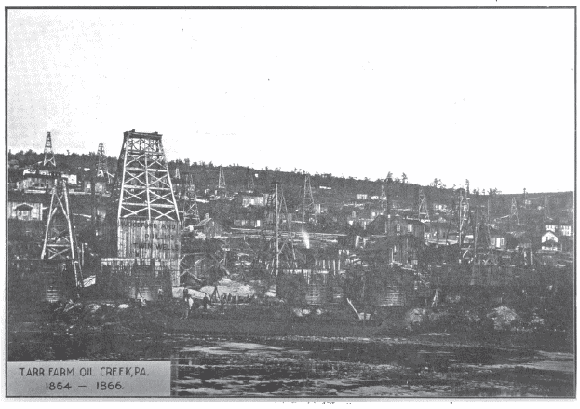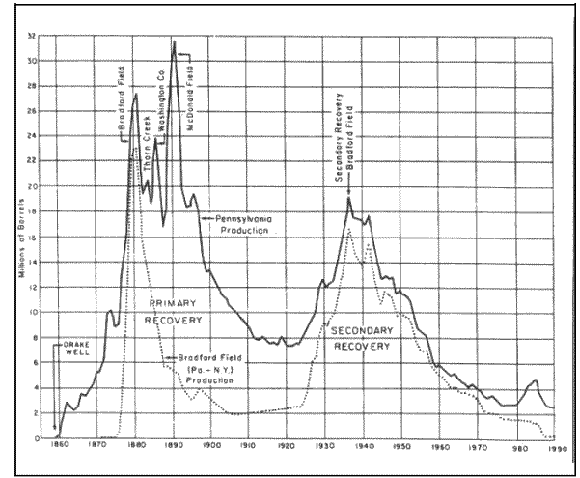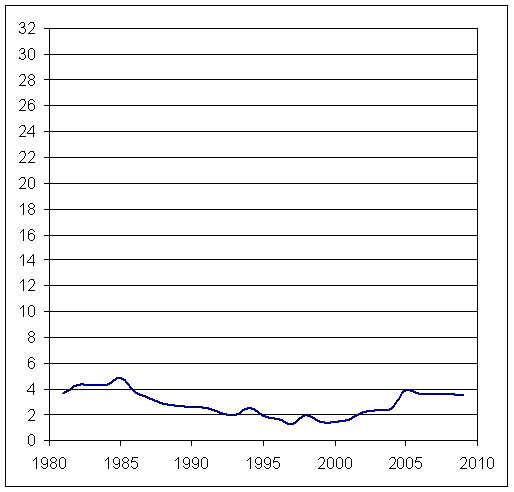Here I pass along a few items on the early history of the oil industry that I found interesting.
The first commercial oil well was completed in Pennsylvania in 1859 under the supervision of Colonel Edwin Drake. Williamson and Daum’s The American Petroleum Industry: The age of illumination, 1859-1899, p. 75 have this colorful description of how Drake earned his colonel’s eagle:
Following [Pennsylvania Rock Oil Company President James] Townsend’s instructions literally, Drake’s first act on arriving in Titusville [PA] brought him what was probably the cheapest, if not the most spurious, colonelcy ever acquired outside the state of Kentucky. Alert to the promotional value of a little showmanship to impress the local citizenry, Townsend had mailed the legal documents ahead to “Colonel” E.L. Drake in care of Brewer, Watson & Company… When Drake called for his mail, he found the townsfolk already interested in and receptive to the great man affairs in their midst, and himself adorned with a new title that would remain with him for life.
Aided by more than a little luck, the colonel did strike oil, and the boom was on. For two decades the state of Pennsylvania was to be the world’s main producer of crude oil. Although production rates from the initial wells on Oil Creek dropped off quickly as the oil was taken out, these were more than replaced by other sources within the state. For example, in 1865, Pithole City, PA became a phenomenal boom town, accounting for a third of the 2.5 million barrels produced in the world that year, only to turn into a ghost town as production rates fell substantially by 1868.

Source: The Oil Well Driller, Charles Whiteshot (1905)
Pennsylvanian production continued to increase as ever-more-productive new fields within the state were developed, reaching almost 32 million barrels in 1891. But I was interested to learn that, despite amazing improvements in technology since the nineteenth century, that was the highest annual production rate that Pennsylvania would ever achieve.

Pennsylvania crude oil production, 1859-1990, in millions of barrels per year. Source: Michael Caplinger (1997)
Here’s an update to the above graph with more recent data. The price increases of the 1970s and 2000s were sufficient to stimulate some increases in Pennsylvanian production. But note that the two graphs here are drawn on the same scale– we’re still under 4 million barrels per year, less than 1/8 of what the sturdy Pennsylvanians of 1891 were able to accomplish. And in 1891, by the way, oil sold for 67 cents a barrel, which corresponds to about $16 in 2009 dollars.

Pennsylvania crude oil production, 1981-2009, in millions of barrels per year. Data source: EIA
- Bulenox: Get 45% to 91% OFF ... Use Discount Code: UNO
- Risk Our Money Not Yours | Get 50% to 90% OFF ... Use Discount Code: MMBVBKSM
Disclaimer: This page contains affiliate links. If you choose to make a purchase after clicking a link, we may receive a commission at no additional cost to you. Thank you for your support!


Leave a Reply